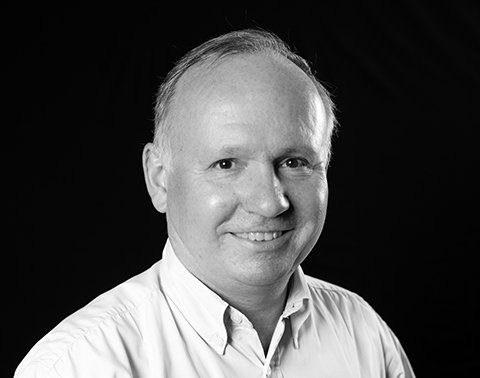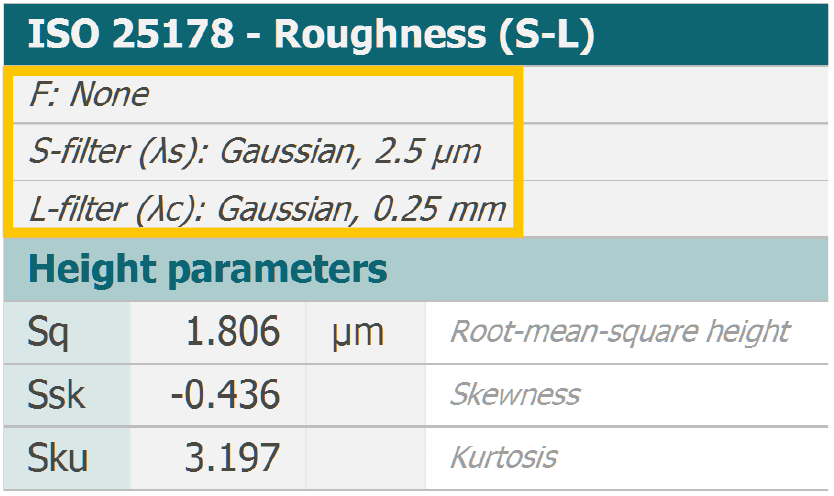With many conferences beginning to restart in person following the pandemic, we’ve noticed the return of a few classic mistakes in conference presentations and papers. Digital Surf’s senior surface metrology expert François Blateyron gives a short review of the main errors that authors should avoid in order to provide sound and replicable results.

1- Never report parameter results without filtering conditions
All too often, scientific papers report surface texture parameters (usually profile parameters such as Ra or Rq) without any filtering conditions. Although ISO 4288 or ISO 21920-3 admit default conditions that can therefore be omitted, they are not always applicable, due to the small size of the measured parts.

Above: Mountains® parameter tables automatically display filtering conditions.
For clarity, parameters should always be provided with the cut-off value and type of filter used. Otherwise, one can obtain any required parameter value simply by tuning the cut-off value, which makes results totally meaningless! Moreover, with the new ISO 21920 standard, parameters are no longer averaged, so the reference standard used should always be stated in the paper.
Takeaway #1: Always provide filtering conditions alongside parameter values.
Read more:
guide.digitalsurf.revelateur.fr/en/guide-default-specifications.html
guide.digitalsurf.revelateur.fr/en/guide-iso-21920-parameters.html
2- Don’t limit analyses to Ra or Sa. Explore other parameters
Surface texture is too often expressed simply as Ra or Sa parameters.
Before jumping on the Ra bandwagon, ask yourself: what am I trying to achieve? What kind of function do I want to characterize? If you’re looking to analyze average roughness height, use Rq instead, which is more closely related to physical phenomena. If you want to characterize a particular function or performance on a surface, try exploring other parameters that will likely be more “pertinent” and better correlated to the process.
In particular, parameters related to height distribution (Rsk and Rku) or to material ratio (Rmr, Rdc) are usually more significant. Many other parameters offer useful insight, for example Rk, Rdq, Sdr, etc.
Takeaway #2: Take the time to think about which parameter is most appropriate for your application.
Read more:
guide.digitalsurf.revelateur.fr/en/guide-surface-function.html
guide.digitalsurf.revelateur.fr/en/guide-iso-13565-parameters.html
3- Avoid using spacing parameters on stochastic profiles
The most common spacing parameter, Rsm, is sometimes used in contexts where it cannot provide sound results. Spacing parameters are Feature parameters that should be used on periodic, pseudo-periodic or structured profiles and not on stochastic profiles.
Here also, filtering conditions are critical to avoid removing wavelengths of interest.
Takeaway #3: Only use spacing parameters on (pseudo-)periodic or structured surfaces
Read more:
guide.digitalsurf.revelateur.fr/en/guide-lateral-features.html
guide.digitalsurf.revelateur.fr/en/guide-iso-12085-parameters.html
guide.digitalsurf.revelateur.fr/en/guide-stochastic-vs-deterministic.html
4- Avoid using default cut-offs
Users are sometimes lost when they have to select cut-offs, and this is why default values are used so frequently. But it is important to remember that filtration is an operation that affects results and even changes the conclusions of a study.
The cut-off value depends on the material or process signature on the surface. It cannot be chosen only with respect to instrument capabilities or measurement length.
Users should carry out explorations to determine at which scales or which wavelengths their material or process will exhibit characteristics of interest. The chosen cut-off value may not necessarily be the default one, nor the same as that used by another user working on another application.
Takeaway #4: Investigate at which bandwidths your study is relevant.
Read more:
guide.digitalsurf.revelateur.fr/en/guide-filtration-techniques.html
guide.digitalsurf.revelateur.fr/en/guide-bandpass-filters.html
5- Do not report Sdr or Sdq without stating surface resolution
Some parameters are calculated with respect to neighboring points, which means that depending on the spacing (lateral resolution), they provide different values.
This is indeed the basis of scale-sensitive fractal analysis (SSFA) where Sdr varies with scale. This applies, in particular, to Rdq/Sdq (mean slope) and Rdr/Sdr (developed area), and even on Spc/Svc (curvature). These parameters are very sensitive to resolution and to noise.
Takeaway #5: Sdr and Sdq parameters should always be accompanied with lateral resolution indications.
Read more:
guide.digitalsurf.revelateur.fr/en/guide-fractal-analysis.html
guide.digitalsurf.revelateur.fr/en/guide-areal-field-parameters.html
Author : François Blateyron
Resources :
Digital Surf Surface Metrology Guide: guide.digitalsurf.revelateur.fr